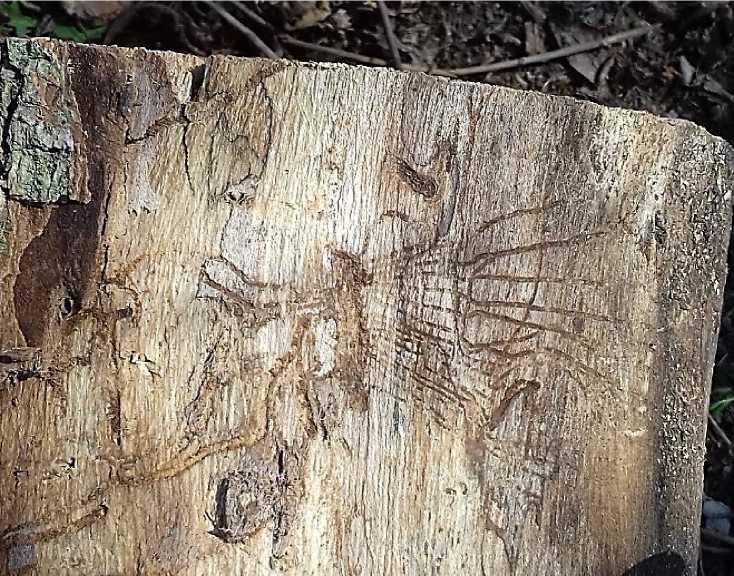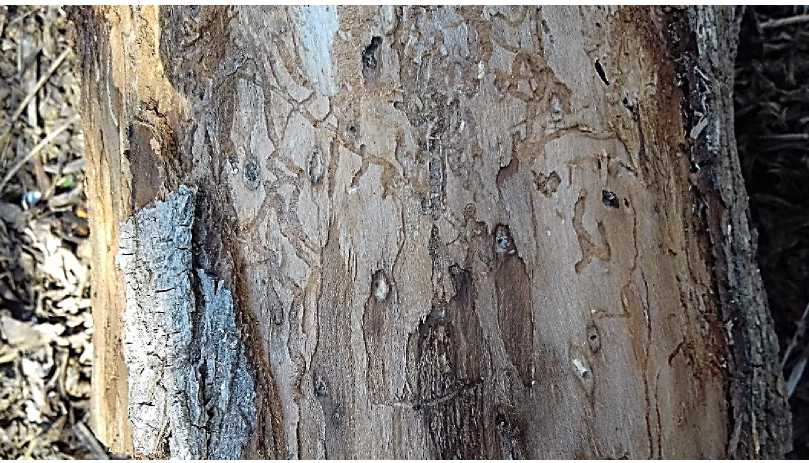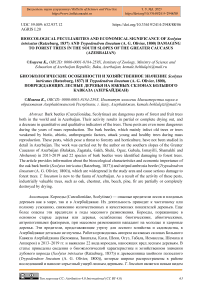Bioecological peculiarities and economical significance of Scolytus intricatus (Ratzeburg, 1837) and Trypodendron lineatum (A. G. Olivier, 1800) damaging to forest trees in the south slopes of the Greater Caucasus (Azerbaijan)
Автор: Isayeva Kamala
Журнал: Бюллетень науки и практики @bulletennauki
Рубрика: Биологические науки
Статья в выпуске: 3 т.9, 2023 года.
Бесплатный доступ
Bark beetles (Curculionidae, Scolytinae) are dangerous pests of forest and fruit trees both in the world and in Azerbaijan. Their activity results in partial or complete drying out, and a decrease in quantitative and qualitative indicators of the trees. These pests are even more dangerous during the years of mass reproduction. The bark beetles, which mainly infect old trees or trees weakened by biotic, abiotic, anthropogenic factors, attack young and healthy trees during mass reproduction. These pests, which pose a threat to forestry and horticulture, have not been studied in detail in Azerbaijan. The work was carried out by the author on the southern slopes of the Greater Caucasus of Azerbaijan (Balakan, Zagatala, Gakh, Sheki, Oguz, Gabala, Ismayilli, Shamakhi and Absheron) in 2013-2019 and 22 species of bark beetles were identified damaging to forest trees. The article provides information about the bioecological characteristics and economic importance of the oak bark beetle ( Scolytus intricatus (Ratzeburg, 1837)) and striped ambrosia beetle ( Trypodendron lineatum (A. G. Olivier, 1800)), which are widespread in the study area and cause serious damage to forest trees. T. lineatum is new to the fauna of Azerbaijan. As a result of the activity of these pests, industrially valuable trees, such as oak, chestnut, elm, beech, pine, fir are partially or completely destroyed by drying.
Curculionidae, larvae, pupae, azerbaijan
Короткий адрес: https://sciup.org/14126836
IDR: 14126836 | УДК: 59.009: | DOI: 10.33619/2414-2948/88/06
Текст научной статьи Bioecological peculiarities and economical significance of Scolytus intricatus (Ratzeburg, 1837) and Trypodendron lineatum (A. G. Olivier, 1800) damaging to forest trees in the south slopes of the Greater Caucasus (Azerbaijan)
Бюллетень науки и практики / Bulletin of Science and Practice Т. 9. №3. 2023
UDC 59.009: 632.937.12
Protecting the ecological balance, preventing water, soil and air pollution is one of the most important requirements of our time. Large-scale reduction of vegetation (under the influence of biotic, abiotic, anthropogenic factors) creates serious difficulties both in Azerbaijan and around the world. Thus, every year in our republic a large number of forest and fruit trees of great economic importance are destroyed by a number of serious harmful insects. Among these pests, bark beetles (Coleoptera, Curculionidae, Scolytinae) are of particular danger.
It is known that there are 6,000 species of bark beetles in the world [1]. According to the type of food, these insects, which are classified as xylophages, develop and feed on the trunks and branches of trees and shrubs. As a result of which, trees partially or completely dry out, causing serious damage to forestry and horticulture. However, despite their great economic importance, these pests have not been studied in detail in Azerbaijan. So, for the first-time bark beetles of Azerbaijan were discovered by N. Kh. Samadov. In his book “Fauna and Biology of Insect Pests of Agricultural Plants in Azerbaijan”, published in 1963, he gives information about 11 species of bark beetles [2]. In subsequent years, the bark beetles of Azerbaijan were studied very little, and detailed and systematic studies were not carried out.
The article presents information about the bioecological characteristics and economic importance of the oak bark beetle ( Scolytus intricatus (Ratzeburg, 1837)) and striped ambrosia beetle ( Trypodendron lineatum (A. G. Olivier, 1800)), which seriously damage forest trees on the southern slopes of the Greater Caucasus (Azerbaijan). Trypodendron lineatum was recorded for the first time for the Azerbaijan fauna.
Material and methods
Research work on the study of bark beetles (Coleoptera, Curculionidae, Scolytinae), damaging forests and fruit trees on the southern slopes of the Greater Caucasus (Azerbaijan) (2013-2019), covered Balakan, Zagatala, Gakh, Sheki, Oguz, Gabala, Ismayilli, Shamakhi, and Absheron regions. The collection and processing of materials were carried out according to generally accepted entomological methods in field and laboratory conditions [3, 4]. Fieldwork has consisted of observations and manual collection (visual inspection). Insects were selected from various vegetative organs of forest plants by cutting and splitting. To determine the species composition of the collected pests, keys, and a microscope MBS-9 were used [5, 6].
Results and discussion
As a result of the research, 22 species of bark beetles were identified that damage forest trees on the southern slopes of the Greater Caucasus (Azerbaijan). Among them, 2 species: oak bark beetle ( Scolytus intricatus (Ratzeburg, 1837)) and striped ambrosia beetle ( Trypodendron lineatum (A. G. Olivier, 1800)) are especially widespread in the study area and cause serious damage to forest trees.
Бюллетень науки и практики / Bulletin of Science and Practice Т. 9. №3. 2023
Genus: Scolytus E. L. Geoffroy, 1762
Scolytus intricatus (Ratzeburg, 1837) — oak bark beetle
Material: District Zagatala, village Muganly, N 41°28′30″, E 46°29′05″, 31.05.2014; 3 adults (2♀1♂) on the oak branch and 1♂ adults on the trunk at a distance of 28-30 cm above the ground. 2♀2♂ (1alive, 3 dead) on a fallen willow stump near the road. 3♀ on the passages of a dead branch of a young chestnut tree in a private plot.
Dist. Zagatala, v. Daghli, N 41°31′23″, E 46°31′55″, 22.07.2013; 12 adults (7♀5♂ (3 dead)), 5 larvae from the wood of a young oak branch broken for any reason.
Dist. Balakan, v. Mazimchay, N 41°48′20″, E 46°21′00″, 24.07.2013; 7 specimens (6♀1♂ (1 dead)) from young oak shoots, growing along roadsides and suffering from drought.
Dist. Gakh, v. Ilisu, N 41°28′07″, E 47°03′31″, 10.06.2014; 1♂ specimens on an oak growing around the village; 2♀2♂ from the galleries of bark beetles under the bark of the branches of a beech in 3 meters from the oak; 17 specimens (11♀6♂) from the beech branches in 30 meters from the oak. 10.06.2016; 3♀ specimens (dead) in bark beetle galleries under the bark of a dead beech trunk in the forest; 9 adults (3♀6♂) from a branch of 21 cm long and ≈ 6 cm in diameter of a young oak growing in the forest.
Dist. Sheki, v. Bolludara, N 40°49'57", E 47°25'38", 19.07.2013; 2♀ dead specimens, 5 immature pupae on a broken beech branch with bark beetle entrance and flight holes. 1♀, 3 pupae from under the bark of a dried willow branch in the yard. 05.30.2015; 4 (1♀3♂) specimens on a young chestnut shoot, 1♀ specimens from the undergrowth under the canopy of the same tree with an entomological bag.
Dist. Oghuz, v. Khalkhal, N 41°05′01″, E 47°32′15″, 04.06.2014; 2♀ specimens on the trunk of a dead oak near the road, 7 specimens (5♀2♂) under the bark of a branch. 08.17.2017; 4 (3♀1♂) specimens from a broken willow branch on the roadside. 07.06.2018; 2♂ adults, 11 pupae, 5 larvae from chestnut.
Dist. Gabala, v. Amirvan, N 40°49′51″, E 47°53′32″, 06.03.2014; 5♀ specimens from chestnut branches in the yard; 11 specimens (7♀4♂) from oaks grown in natural conditions around the village and weakened by the attack of primary pests. 12.08.2018; 7♂13♀ in the willow branches on the roadside.
Dist. Shamakhi, settl. Pirgulu, N 40°41′23″, E 48°37′35″, 08.27.2016; 13 specimens (6♀7♂) from chestnut branches grown in the forest. 3 specimens (1♀2♂) from a birch; 5 specimens (1♀4♂) on a birch branch; 1♂ specimens from a split dry branch of a dead elm plant.
The oak bark beetle is widespread on the southern slopes of the Greater Caucasus (Azerbaijan) and causes serious damage to forest trees. This species is mainly found in oak, chestnut, beech, willow, and birch. During observations, insects and their galleries were most often recorded in the thin-skinned parts of the trunk (old and young branches). For example, during research on the territory of the district Zagatala, the oak beetle was most often recorded on the young branches with a diameter of 8-10 cm. Because this species usually either attacks young trees or settles in the crowns of old trees. During our observations in nature the oak bark beetle was rarely found on middle-aged or old trees. The intensity of occurrence of this species was high in young oaks weakened by biotic, abiotic, or anthropogenic impacts.
During observations, it was found that a few days after gnawing the surface of the branch the adults completely bore into it, where they open short uterine tunnels that are simple in shape. These tunnels seriously damage the wood. The galleries of the larvae are very long, in contrast to the tunnels of the mother. The larval runnels are at first straight when departing from the maternal tunnel, and then bend relatively downward or upward (Figure 1). According to literature data, relatively low temperatures lead to an increase in the duration of the larval stage [7]. It has been established that in the study area it gives one generation per year. These beetles often spread within their range an infection called oak vein disease (Ophiostoma) [8, 9].

Figure 1. Scolytus intricatus galleries
Genus: Trypodendron J. F. Stephens, 1830
Trypodendron lineatum (A. G. Olivier, 1800) — striped ambrosia beetle
Material: Dist. Zagatala, N 41°33′, E 46°43′, 05.30.2014; 3♀ from a pine branch planted on the roadside for the purpose of landscaping. August 2015; 33♀24♂ (11 dead) from pine and spruce planted in different parts of the city for decorative and landscaping purposes. 08.23.2017; 11♂4♀ from pine and fir in different parts of the city.
Dist. Sheki, v. Kish, N 41°15'00", E 47°11'30", 07.05.2016; 11♂7♀ (2 dead) from branches of middle-aged and old coniferous trees.
Dist. Sheki, v. Bolludara, N 40°49'57", E 47°25'38", 07.16.2014; 5♀2♂ from coniferous trees planted for landscaping in the village.
Dist. Gabala, N 40°58'53", E 47°50'45", July 2014; 23♀17♂ (9 dead) from pine and spruce, planted in different parts of the city in decorative and landscaping purposes. 08.22.2017; 3♂1♀ from decorative conifers in the park and on the roadside. 08.29.2018; 4 ♀ from dry pine branches.
Dist. Ismayilli — 40°51'11"N, 48°23'35"N, 05.28.2015; 5♀3♂, 4 pupae from ornamental pine and spruce. August 2018; 9♂14♀ of conifers planted for landscaping.
Absheron region — 40°27'26" N, 49°44'18" N, 06.11.2013; 3♂1♀, 2 pupae from pine and spruce. 07.21.2014; 7♂11♀ (4 dead) from pine in dry area. 05.23.2015; 18♀22♂, 12 pupae from coniferous trees planted for landscaping in parks and roadsides. 07.06.2017; 17♂12♀ from coniferous trees of Absheron region. 06.14.2018: 6♀2♂, 4 pupae from a cut spruce branch.
On the southern slopes of the Greater Caucasus (Azerbaijan), this species mainly damages conifers. T. linear is moisture-loving species. So, it is recorded that the insect attacks trees, stumps and building materials in places not exposed to the sun. The main host plants are pine and fir. It was recorded in both old and young trees in the study area. The insect also attacks damaged or weakened trees and, in most cases, cause them to dry out completely. During observations in nature, the entrance holes opened by this species were found mainly in the thick bark of the trunk. To bore into the tree, this species makes an entrance hole, usually in damaged parts of the bark. Females lay eggs singly, and the tunnels opened by the hatching larvae are short (Figure 2). When studying the tunnels opened by the T. linear, in many cases darkening of the inner walls of these tunnels was recorded. According to the literature, this is caused by the darkening of the fungal mycelium in the walls of the maternal and larval tunnels [10]. The species gives one generation per year in the study area.

Figure 2. Trypodendron lineatum galleries
Conclusion
Thus, as a result of the research, 22 species of bark beetles damaging forest trees on the southern slopes of the Greater Caucasus (Azerbaijan) were recorded. Among them, 2 species the oak bark beetle ( S. intricatus ) and striped ambrosia beetle ( T. lineatum ) are especially widespread in the study area and cause serious damage to forest trees. Thus, as a result of the activity of these pests, industrially valuable trees such as oak, chestnut, elm, beech, pine, and fir are partially or completely destroyed by drying out.
Species T. lineatum is first recorded for the fauna of Azerbaijan.
Список литературы Bioecological peculiarities and economical significance of Scolytus intricatus (Ratzeburg, 1837) and Trypodendron lineatum (A. G. Olivier, 1800) damaging to forest trees in the south slopes of the Greater Caucasus (Azerbaijan)
- Мандельштам М. Ю., Селиховкин А. В. Короеды Северо-Запада Рос сии (Coleoptera, Curculionidae: Scolytinae): история изучения, состав и генезис фауны // Энтомологическое обозрение. 2020. Т. 99. №3. С. 631-665.
- Самедов Н. Г. Фауна и биология жуков, вредящих сельскохозяйственным культурам в Азербайджане. Баку: Изд-во АН Азерб., 1963. 383 с.
- Quliyeva H. F. Entomologiyanın tədqiqat metodları. Bakı: Zərdabi LTD, 2015. 262 s.
- Старк В. Н. Инструкция по собиранию и изучению короедов (İpidae). М.;Л.: Изд-во АН СССР, 1936. 88 с.
- Бей-Биенко Г. Я. Определитель насекомых европейской части СССР. М.;Л.: Наука, Т. 2: Жесткокрылые и веерокрылые. 1965. 668 с.
- Батиашвили И. Д., Бей-Биенко Г. Я., Щеголев В. Н. Определитель насекомых по повреждениям культурных растений. М.; Л.: Сельхозгиз, 1952. 604 с.
- Galko J., Økland B., Kimoto T., Rell S., Zúbrik M., Kunca A., Nikolov C. Testing temperature effects on woodboring beetles associated with oak dieback // Biologia. 2018. V. 73. P. 361-370.
- Аверкиев И. С. Атлас вреднейших насекомых леса. М.: Лесная промышленность, 1984. 72 с.
- Воронцов А. И. Лесная энтомология. М.: Высшая школа, 1967. 399 с.
- Старк В. Н. Фауна СССР: Жесткокрылые. М.: Изд-во АН CCCР, Т. 31: Короеды. 1952. 461 с.


